
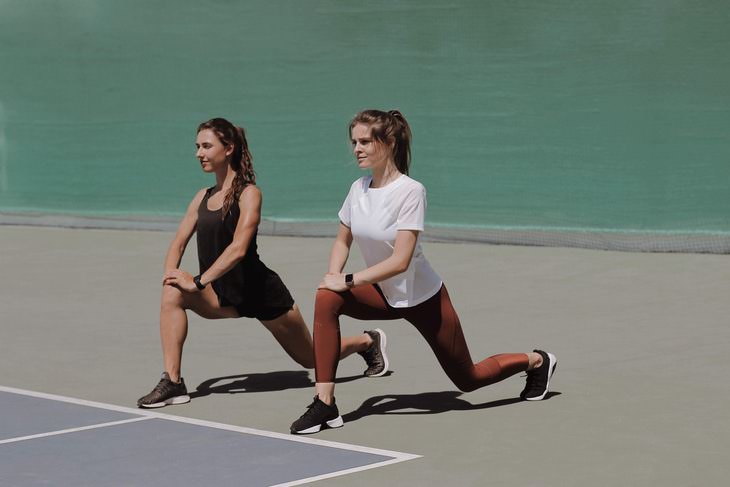
New to exercising? Chair squats are an excellent beginner’s exercise for building up strength in the legs without applying excessive pressure on the hamstrings, quads, and glutes.
How to complete the exercise:
1. Stand straight in front of a chair with your feet shoulder-width apart.
2. Engage the core muscles and start lowering the hips down, barely touching the chair, and then lifting back up. The glutes and hamstrings should be active as you’re moving up and down.
Start with 10 repetitions and ultimately move to 3 sets of 10 reps.
Adjustments:
Related Article: The Best Exercises For Seniors You Can Do in a Seated Position
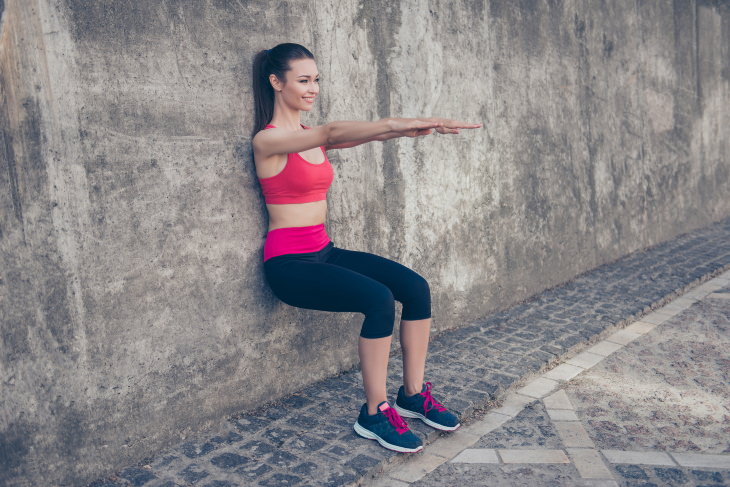
Wall squats are another simplified squat variation. This exercise is especially beneficial for those prone to knee pain, as contact with the wall helps take pressure off the knees.
How to complete the exercise:
1. Stand with your back against a wall. Your feet should be around 12 inches away from the wall.
2. Bend your knees and move down along the wall. Your back should be touching the wall throughout the exercise.
3. When your thighs are parallel to the floor, stop moving down and move back up, pushing back up to the initial position.
Start with 10 repetitions and ultimately move to 3 sets of 10 reps.
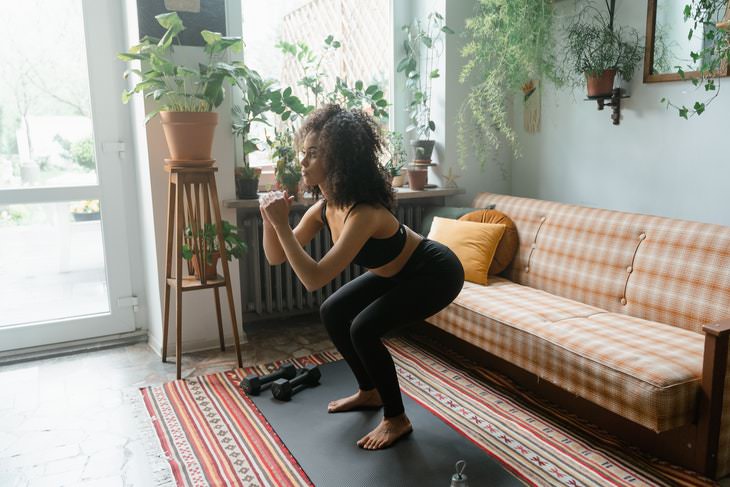
The bodyweight squat is the classic version of this exercise. It targets the core, quads, gluteus maximus, and hamstrings. Mastering this basic move is mandatory for other squat variations.
How to complete the exercise:
1. Start in a standing position. The feet should e slightly wider than hip-width apart and toes turned out only slightly. The arms should be at your sides, palms turning in.
2. Engage the abdominal muscles and shift the body weight to the heels. Start pushing the hips back and lower into a squat, bending the knees.
3. As you lower into a squat, bend the arms and connect them in front of your chest. Lower until the thighs are parallel to the floor.
4. Move up, pushing from your heels and really squeezing the glutes until you return to the initial position.
Start with 10 repetitions and ultimately move to 3 sets of 10 reps.
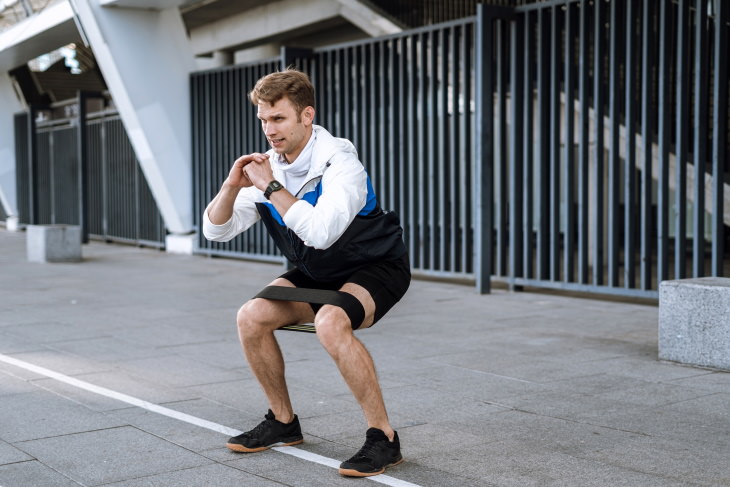
Also known as a ‘banded squat,’ this type of squat is similar to a regular squat, but it has more resistance and therefore is a bit more challenging. A resistance band can also improve your squatting technique, as it will make sure that you’re aligning your knees correctly as you squat.
How to complete the exercise:
1. Stand up and place the resistance band right above the knees. The feet should be slightly wider than hip-width apart and the toes should be turned out slightly.
2. Bend the knees and start lowering into a squat, but make sure that your knees are pushing sideways against the band.
3. As you stand back up, it’s okay if the band is slightly looser.
Start with 10 repetitions and ultimately move to 3 sets of 10 reps.
Adjustments:
This resistance band squat variation activates a specific muscle called the gluteus medius in just a few steps. The gluteus medius is one of the most often overlooked and weakened muscles. And if you pick up the pace a little, you can also increase the heart rate.
How to complete the exercise:
1. Begin in a squat position, with hands in front of the chest.
2. Make a few small steps to the side, then move back. This is one rep.
Start with 10 repetitions and ultimately move to 3 sets of 10 reps.
Related Article: 6 Quick Resistance Band Exercises
These exercises are getting trickier and trickier. This single-side exercise will activate your core and legs, and it challenges the sense of balance as well.
How to complete the exercise:
1. Stand around 2 feet in front of a chair and stretch the right leg back, placing the top of the foot on the surface.
2. Bend the left knee and start lowering down until the right knee barely touches the floor. Make sure that your shoulders are relaxed and your back is straight.
3. Lift back to the initial position. Switch legs, and repeat on the other side.
Start with 10 repetitions and ultimately move to 3 sets of 10 reps.
Pistol squats engage are a wide range of muscles, including the hip abductors, core muscles, glutes, quads, calves, and hamstrings at the same time. These unilateral squats are considered extremely beneficial for both balance and single-leg strength, but they can be challenging for beginners. This simplified version is more beginner-friendly, but it’s still quite demanding.
How to complete the exercise:
1. Stand in front of a chair and the right foot hovering.
2. Engage the abdominal muscles and shift the body weight to the heels. Start pushing the hips back and lower into a squat, bending the knees.
3. Pushing from your left heel and engaging both the core and the left hip, slowly rise back to the initial position.
4. This is one repetition. Repeat the same steps on the other side.
Start with 10 repetitions and ultimately move to 3 sets of 10 reps.
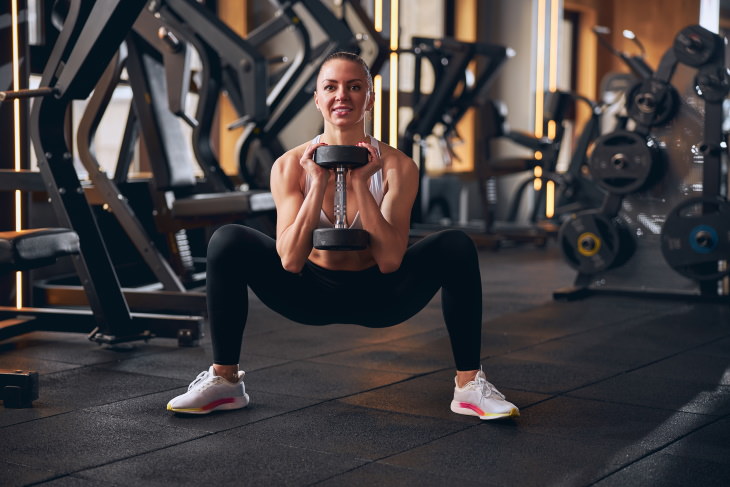
If you have a weight or kettlebell, a goblet squat is an excellent exercise to engage the biceps, core, gluteus maximus, quadriceps, and hamstrings. It requires holding the weight in a goblet position.
How to complete the exercise:
1. Stand with your feet a little wider than hip-width apart and feet pointed slightly out. Hold a weight in both hands in front of you.
2. Engage your core and keep your chest lifted and back flat as you shift your weight into your heels, push your hips back, and bend your knees to lower into a squat. Lower until the thighs are parallel to the floor.
3. Move up, pushing from your heels and really squeezing the glutes until you return to the initial position.
Start with 10 repetitions and ultimately move to 3 sets of 10 reps.
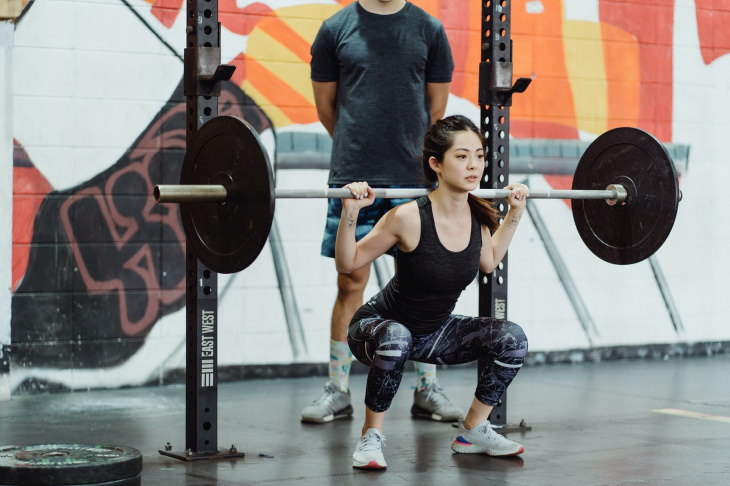
If you’re working out at the gym or just have a barbell and weights at home, the barbell back squat is a good place to start before you move to the front squat. During this exercise, a barbell is placed on the back of your neck (the trapezius muscles). You should only try this exercise once you’ve already developed a good squatting posture. If you’re still at the transitional stage, a similar effect can be achieved by holding two dumbbells at shoulder level.
How to complete the exercise:
1. Stand with your feet a little wider than hip-width apart and feet pointed slightly out. Grab a barbell. Your hands should be a bit wider than shoulder-width apart.
2. Move underneath the bar and place the upper back against it. Really squeeze the shoulder blades together to create a muscle “cushion” for the bar to stay on.
3. Unrack the barbell, and move back.
4. Prepare for a squat by pushing your hips back and slowly bending your knees.
5. Lower to a squat, and then rise while squeezing your glutes. Place the barbell back on the rack. This is one repetition.
Start with 10 repetitions and ultimately move to 3 sets of 10 reps.
Share this article with others!